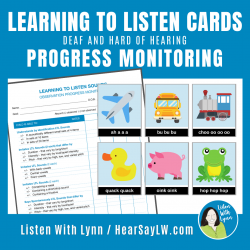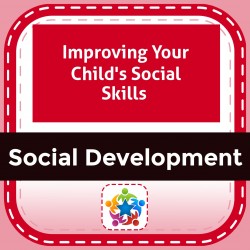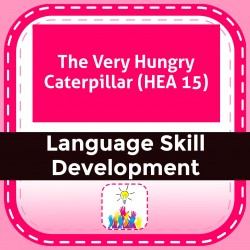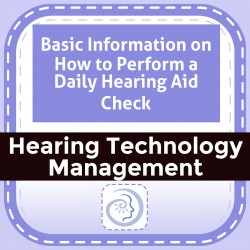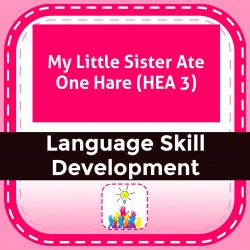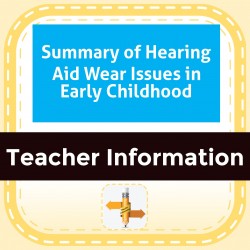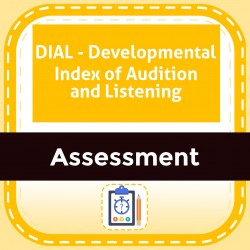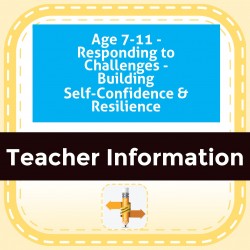Ability Levels
Categories
Resource Types
Age/Grade Range
CCSS
Anchor Standard
Speaking & Listening
Language
Reading
Information Exchange Form - Supporting the Child with Cochlear Implant
$ 0
This form is designed to be used, with parent permission, to gather relevant information about a child with cochlear implants or hearing aids including all service providers, hearing device informatio
...
n, communication checklist, MaP or hearing aid fitting information.
Learning To Listen Cards and Progress Monitoring Tool
$ 5
This resource includes a printable set of 30 Learning to Listen* Cards, an Observation Progress Monitoring Tool, and Tips For parents and professionals teaching the Learning To Listen Sounds and Phras
...
rases to a young child who is deaf or hard of hearing utilizing hearing technology such as cochlear implants or hearing aids with the goal of learning to listen and talk. INCLUDES:High-resolution Learning To Listen cards for quality printingObservation Progress Monitoring Tool10 Tips For teaching the Learning To Listen Sounds and PhrasesListening to Listen Sounds - Actions and AdjectivesLearning to Listen Sound - Object AssociationsLearning to Listen Sounds are associated with toys and objects that are commonly part of a baby or young child’s daily routines and activities. Individual families may use a variety of different Learning to Listen sounds, words and phrases depending on their lifestyle and culture. These onomatopoeic sounds contain acoustic properties that are significant in the perception of speech. The Learning to Listen Sounds are easy to hear for most babies wearing hearing technology.Skilled interventionists coach parents and caregivers about auditory skill development while presenting the Learning to Listen toys or activities. Observation data can be collected about the child’s auditory access to aspects of speech like duration, intensity, pitch, and voicing as well as vowel and consonant perception by contrasting toys in strategically chosen groups. This information is critical for optimally setting hearing aids and programming cochlear implants.*Adapted from Simser, 2002, Estabrooks, 2006, Estabrooks & Birkenshaw-Fleming, 1994.
Improving Your Child's Social Skills
$ 0
Handout describing social skills, social cues, and tiPS- for teaching social skills and self-esteem.
The Very Hungry Caterpillar (HEA 15)
$ 195
The Very Hungry Caterpillar - Early Childhood / Preschool teaching materials for the book includes a) a synopsis of the storybook b) a letter to send home to families explaining the storybook unit and
...
activities they can do at home c) suggestions for setting up your classroom to revolve around the story (dramatic play area, sensory area, art area, science area, book area, and bulletin board) d) activities separated into two weeks, each week including: a distinctive thematic, e) focus of the Week; Circle Time activities including songs, poems, fingerplays, and story-reading ideas; and six detailed Group Activities with designated target areas, f) snacks related to the story, g) a Pretest and Posttest
End of the Year Vocabulary Exposure Challenge
$ 5
We all know that our DHH learners need to be taught vocabulary intentionally for a number of reasons. We also know that students need to be exposed to vocabulary words several times in order for them
...
to internalize them. Vocabulary development is a crucial skill for our DHH learners. I created this resource for teachers to provide to families and/or older students during summer break.Encourage families to join this vocabulary exposure challenge over the summer! This resource contains 7 summer-themed word lists that can be given to families and students. Challenge families to take action and pick at least one word per day to use with their DHH learner in context. Have the families talk about the words with the students. Or, you can encourage your older students to pick one word a day to use and look up. Along with the lists, there is a chart that can be used to track the words that are used weekly.This could also be used as a resource for ELL learners or enrichment for students.
Basic Information on How to Perform a Daily Hearing Aid Check
$ 0
This handout provides a step-by-step approach to performing a hearing aid check. Includes images, descriptions, and rationale. Also has images for putting hearing aids on.
My Little Sister Ate One Hare (HEA 3)
$ 195
My Little Sister Ate One Hare - Early Childhood / Preschool teaching materials for the book includes a) a synopsis of the storybook b) a letter to send home to families explaining the storybook unit a
...
nd activities they can do at home c) suggestions for setting up your classroom to revolve around the story (dramatic play area, sensory area, art area, science area, book area, and bulletin board) d) activities separated into two weeks, each week including: a distinctive thematic, e) focus of the Week; Circle Time activities including songs, poems, fingerplays, and story-reading ideas; and six detailed Group Activities with designated target areas, f) snacks related to the story, g) a Pretest and Posttest
Summary of Hearing Aid Wear Issues in Early Childhood
$ 1
Summary of issues in getting young children to use hearing aids and what families can do. Chart listing why children may reject their hearing aids and what families can do when the child rejects heari
...
ng aids. Divided into age ranges from K-2; 3-5 years. Also includes information on baby temperament as it can effect hearing aid use and the powerful handout Attitude is Caught, Not Taught which sheds light on how parent behavior helps shape child attitudes toward hearing aid use and hearing loss.
DIAL - Developmental Index of Audition and Listening
$ 0
Chart listing listening behaviors at specific ages ranging from 0-28 days through 22 years.
Age 7-11 - Responding to Challenges - Building Self-Confidence & Resilience
$ 250
For ages 7-11 years: This information addresses the components of resilience, building perseverance, goal setting, learning chunking skills, problem-solving, using humor, and reconciling feelings of f
...
itting in. The purpose of this book is to raise awareness for the reasons why hearing device rejection happens and specific instruction to occur at different ages to build student resilience and self-confidence, thereby increasing the likelihood that they will not reject using their hearing technology. Specific teaching activities and recommendations for instructional materials to develop identified skills have been included in this Guide.
 Your browser is out of date. For best experience switch to latest updated Browser.
Your browser is out of date. For best experience switch to latest updated Browser.
 Get Chrome
Get Chrome Get Edge
Get Edge Get Firefox
Get Firefox
